display Alfa Romeo Giulietta 2018 Owner's Guide
[x] Cancel search | Manufacturer: ALFA ROMEO, Model Year: 2018, Model line: Giulietta, Model: Alfa Romeo Giulietta 2018Pages: 216, PDF Size: 3.39 MB
Page 89 of 216
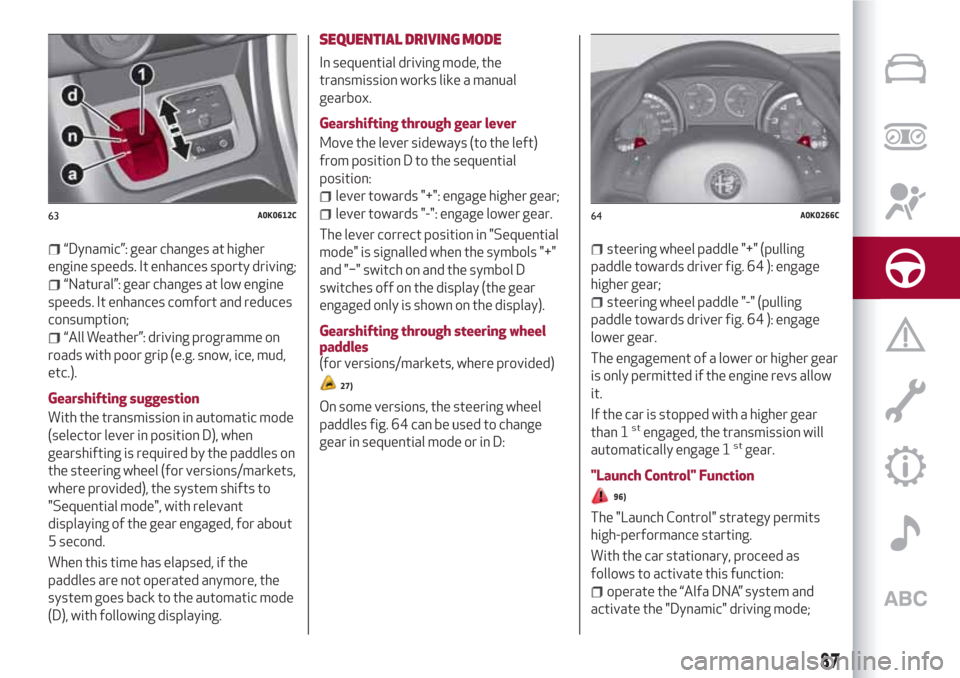
“Dynamic”: gear changes at higher
engine speeds. It enhances sporty driving;
“Natural”: gear changes at low engine
speeds. It enhances comfort and reduces
consumption;
“All Weather”: driving programme on
roads with poor grip (e.g. snow, ice, mud,
etc.).
Gearshifting suggestion
With the transmission in automatic mode
(selector lever in position D), when
gearshifting is required by the paddles on
the steering wheel (for versions/markets,
where provided), the system shifts to
"Sequential mode", with relevant
displaying of the gear engaged, for about
5 second.
When this time has elapsed, if the
paddles are not operated anymore, the
system goes back to the automatic mode
(D), with following displaying.
SEQUENTIAL DRIVING MODE
In sequential driving mode, the
transmission works like a manual
gearbox.
Gearshifting through gear lever
Move the lever sideways (to the left)
from position D to the sequential
position:
lever towards "+": engage higher gear;
lever towards "-": engage lower gear.
The lever correct position in "Sequential
mode" is signalled when the symbols "+"
and "−" switch on and the symbol D
switches off on the display (the gear
engaged only is shown on the display).
Gearshifting through steering wheel
paddles
(for versions/markets, where provided)
27)
On some versions, the steering wheel
paddles fig. 64 can be used to change
gear in sequential mode or in D:
steering wheel paddle "+" (pulling
paddle towards driver fig. 64 ): engage
higher gear;
steering wheel paddle "-" (pulling
paddle towards driver fig. 64 ): engage
lower gear.
The engagement of a lower or higher gear
is only permitted if the engine revs allow
it.
If the car is stopped with a higher gear
than 1
stengaged, the transmission will
automatically engage 1stgear.
"Launch Control" Function
96)
The "Launch Control" strategy permits
high-performance starting.
With the car stationary, proceed as
follows to activate this function:
operate the “Alfa DNA” system and
activate the "Dynamic" driving mode;
63A0K0612C64A0K0266C
87
Page 91 of 216
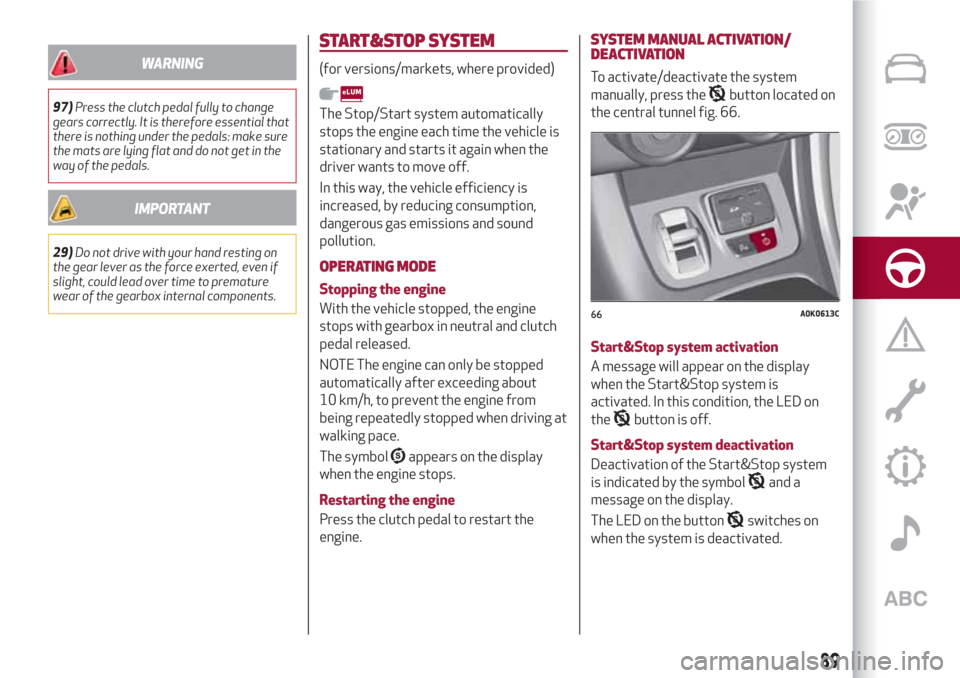
WARNING
97)Press the clutch pedal fully to change
gears correctly. It is therefore essential that
there is nothing under the pedals: make sure
the mats are lying flat and do not get in the
way of the pedals.
IMPORTANT
29)Do not drive with your hand resting on
the gear lever as the force exerted, even if
slight, could lead over time to premature
wear of the gearbox internal components.
START&STOP SYSTEM
(for versions/markets, where provided)
The Stop/Start system automatically
stops the engine each time the vehicle is
stationary and starts it again when the
driver wants to move off.
In this way, the vehicle efficiency is
increased, by reducing consumption,
dangerous gas emissions and sound
pollution.
OPERATING MODE
Stopping the engine
With the vehicle stopped, the engine
stops with gearbox in neutral and clutch
pedal released.
NOTE The engine can only be stopped
automatically after exceeding about
10 km/h, to prevent the engine from
being repeatedly stopped when driving at
walking pace.
The symbol
appears on the display
when the engine stops.
Restarting the engine
Press the clutch pedal to restart the
engine.
SYSTEM MANUAL ACTIVATION/
DEACTIVATION
To activate/deactivate the system
manually, press the
button located on
the central tunnel fig. 66.
Start&Stop system activation
A message will appear on the display
when the Start&Stop system is
activated. In this condition, the LED on
the
button is off.
Start&Stop system deactivation
Deactivation of the Start&Stop system
is indicated by the symbol
and a
message on the display.
The LED on the button
switches on
when the system is deactivated.
66A0K0613C
89
Page 92 of 216
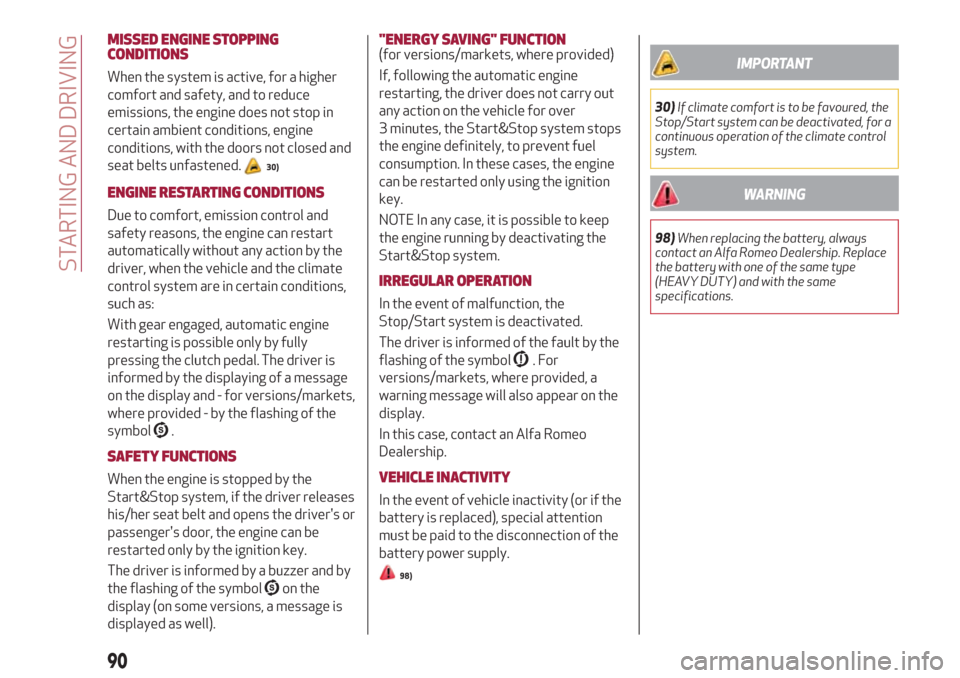
MISSED ENGINE STOPPING
CONDITIONS
When the system is active, for a higher
comfort and safety, and to reduce
emissions, the engine does not stop in
certain ambient conditions, engine
conditions, with the doors not closed and
seat belts unfastened.
30)
ENGINE RESTARTING CONDITIONS
Due to comfort, emission control and
safety reasons, the engine can restart
automatically without any action by the
driver, when the vehicle and the climate
control system are in certain conditions,
such as:
With gear engaged, automatic engine
restarting is possible only by fully
pressing the clutch pedal. The driver is
informed by the displaying of a message
on the display and - for versions/markets,
where provided - by the flashing of the
symbol
.
SAFETY FUNCTIONS
When the engine is stopped by the
Start&Stop system, if the driver releases
his/her seat belt and opens the driver's or
passenger's door, the engine can be
restarted only by the ignition key.
The driver is informed by a buzzer and by
the flashing of the symbol
on the
display (on some versions, a message is
displayed as well).
"ENERGY SAVING" FUNCTION(for versions/markets, where provided)
If, following the automatic engine
restarting, the driver does not carry out
any action on the vehicle for over
3 minutes, the Start&Stop system stops
the engine definitely, to prevent fuel
consumption. In these cases, the engine
can be restarted only using the ignition
key.
NOTE In any case, it is possible to keep
the engine running by deactivating the
Start&Stop system.
IRREGULAR OPERATION
In the event of malfunction, the
Stop/Start system is deactivated.
The driver is informed of the fault by the
flashing of the symbol
.For
versions/markets, where provided, a
warning message will also appear on the
display.
In this case, contact an Alfa Romeo
Dealership.
VEHICLE INACTIVITY
In the event of vehicle inactivity (or if the
battery is replaced), special attention
must be paid to the disconnection of the
battery power supply.
98)
IMPORTANT
30)If climate comfort is to be favoured, the
Stop/Start system can be deactivated, for a
continuous operation of the climate control
system.
WARNING
98)When replacing the battery, always
contact an Alfa Romeo Dealership. Replace
the battery with one of the same type
(HEAVY DUTY) and with the same
specifications.
90
STARTING AND DRIVING
Page 94 of 216

WARNING
99)When travelling with the device active,
never move the gear lever to neutral.
100)In case of a malfunction or failure of
the device, contact an Alfa Romeo
Dealership.
PARKING SENSORS
(for versions/markets, where provided)
These are located in the car's front
bumper and rear bumper and their
function is to inform the driver, through
an intermittent acoustic signal, about the
presence of obstacles in front of and
behind the car.
ACTIVATION
Version with rear sensors
On the versions with rear sensors, the
system is activated when the reverse
gear is engaged.
Version with front and rear sensors
On versions with front sensors and rear
sensors, the system is activated when
the reverse gear is engaged or by
pressing the button on the centre console
.
When reverse gear is released, the front
and rear sensors remain activated until a
speed of around 15 km/h is exceeded to
allow the parking manoeuvre to be
completed.
The sensors are deactivated by pressing
the button
again or when a speed of
15 km/h is exceeded: the LED in the
button is off when the system is not
active.
INDICATIONS ON DISPLAY(for versions/markets, where provided)
Versions with rear sensors
On activating the sensors, the image of
the vehicle with rear distance bars will
appear on the "Reconfigurable
Multifunction Display".
Versions with front and rear sensors
On activating the sensors, the image of
the vehicle with front and rear distance
bars will appear on the "Reconfigurable
Multifunction Display".
Obstacle presence and distance
information is therefore provided both
by the buzzer (volume of the acoustic
warning cannot be adjusted) and the
indication on the display.
If there are several obstacles, the closest
one is displayed. On the version with
front and rear sensors, the closest
obstacle in the front area and in the rear
area is displayed.
ACOUSTIC SIGNAL
The information concerning the presence
and distance of an obstacle from the car
is transmitted to the driver by means of
acoustic signals from buzzers installed in
the passenger compartment.
92
STARTING AND DRIVING
Page 123 of 216

FUEL CUT-OFFSYSTEM
Operation
This intervenes in the case of an impact
causing:
the fuel supply cut-off with the engine
consequently switching off;
the automatic unlocking of the doors;
the switching on of the interior lights.
The intervention of the system is
indicated by a message shown on the
display.
Carefully check the vehicle for fuel leaks,
for instance in the engine compartment,
under the vehicle or near the tank area.
125)
After a collision, turn the ignition key to
STOP to prevent the battery from
running down.
To restore the correct operation of the
car, proceed as follows:
turn the ignition key to the MAR
position;
activate the right direction indicator;
deactivate the right direction
indicator;
activate the left direction indicator;
deactivate the left direction indicator;
activate the right direction indicator;
deactivate the right direction
indicator;
activate the left direction indicator;
deactivate the left direction indicator;
ignition key turned to the OFF
position;
turn the ignition key to the MAR-ON
position.
WARNING
125)If, after an impact, you smell fuel or
notice leaks from the fuel system, do not
reactivate the system to avoid the risk of
fire.
TCT - KEY REMOVAL
The ignition key can be removed only if
the gear lever is in position P (Park).
If the battery is flat and the ignition key is
engaged, the latter is locked in position.
To remove the key manually, proceed as
follows:
apply the handbrake;
dashboard fuses (to remove, insert
your hand in housing 1 fig. 106and lower
flap 2);
using the Allen key provided (see
fig. 107) unscrew the two top screws 2
fig. 108securing cover 1;
106A0K0527C
121
Page 178 of 216

TIPS, CONTROLS AND GENERAL
INFORMATION
TIPS
Road safety
Learn how to use the various system
functions before setting off.
Read the instructions for the system
carefully before setting off.
145) 146)
Reception conditions
Reception conditions change constantly
while driving. Reception may be
interfered with by the presence of
mountains, buildings or bridges,
especially when you are far away from
the broadcaster.
IMPORTANT The volume may be
increased when receiving traffic
bulletins.
Care and maintenance
52) 53)
Observe the following precautions to
ensure the system is fully operational:
never use alcohol, petrol or
petroleum-based solvents to clean the
display screen;
the display is sensitive to scratching,
liquids and detergents. The display
should not come into contact with
pointed or rigid objects which could
damage its surface. Do not press on the
display when cleaning it;
prevent any liquid from entering the
system: this could damage it beyond
repair.
SAFETY SETTINGS
Look at the screen only and when it is
necessary and safe. If you need to look at
the screen for a long time, pull over to a
safe place so as not to be distracted
while driving.
Immediately stop using the system in the
event of a fault. Otherwise the system
might be damaged. Contact an Alfa
Romeo Dealership as soon as possible to
have the system repaired.
WARNING
145)Follow the safety rules here below:
otherwise serious injuries may occur to the
occupants or the system may be damaged.
146)If the volume is too loud this can be
dangerous. Adjust the volume so that you
can still hear background noises (e.g. horns,
ambulances, police vehicles, etc.).
IMPORTANT
52)Only clean the front panel and the
display lens with a soft, clean, dry, anti-static
cloth. Cleaning and polishing products may
damage the surface. Never use alcohol,
petrols and derivatives.53)Do not use the display as a base for
supports with suction pads or adhesives for
external navigators or smartphones or
similar devices
176
MULTIMEDIA
Page 180 of 216
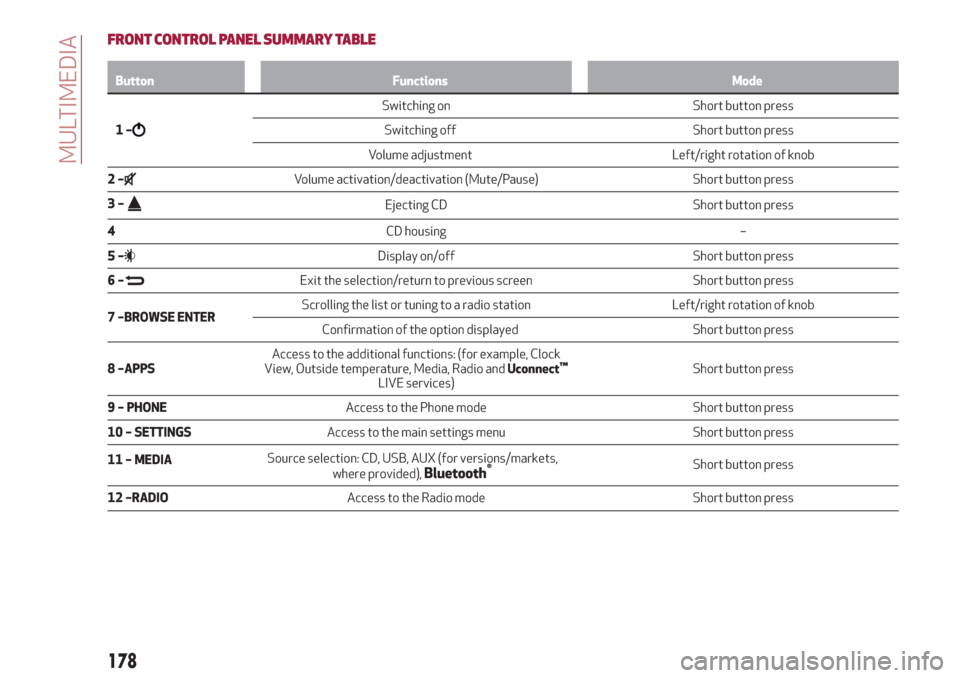
FRONT CONTROL PANEL SUMMARY TABLE
Button Functions Mode
1–
Switching on Short button press
Switching off Short button press
Volume adjustment Left/right rotation of knob
2–
Volume activation/deactivation (Mute/Pause) Short button press
3–
Ejecting CD Short button press
4CD housing –
5–
Display on/off Short button press
6–
Exit the selection/return to previous screen Short button press
7 –BROWSE ENTERScrolling the list or tuning to a radio station Left/right rotation of knob
Confirmation of the option displayed Short button press
8 –APPSAccess to the additional functions: (for example, Clock
View, Outside temperature, Media, Radio andUconnect
™LIVE services)Short button press
9 – PHONEAccess to the Phone mode Short button press
10 – SETTINGSAccess to the main settings menu Short button press
11 – MEDIA
Short button press
12 –RADIOAccess to the Radio mode Short button press
178
MULTIMEDIA
Source selection: CD, USB, AUX (for versions/markets,
where provided),Bluetooth®
Page 183 of 216
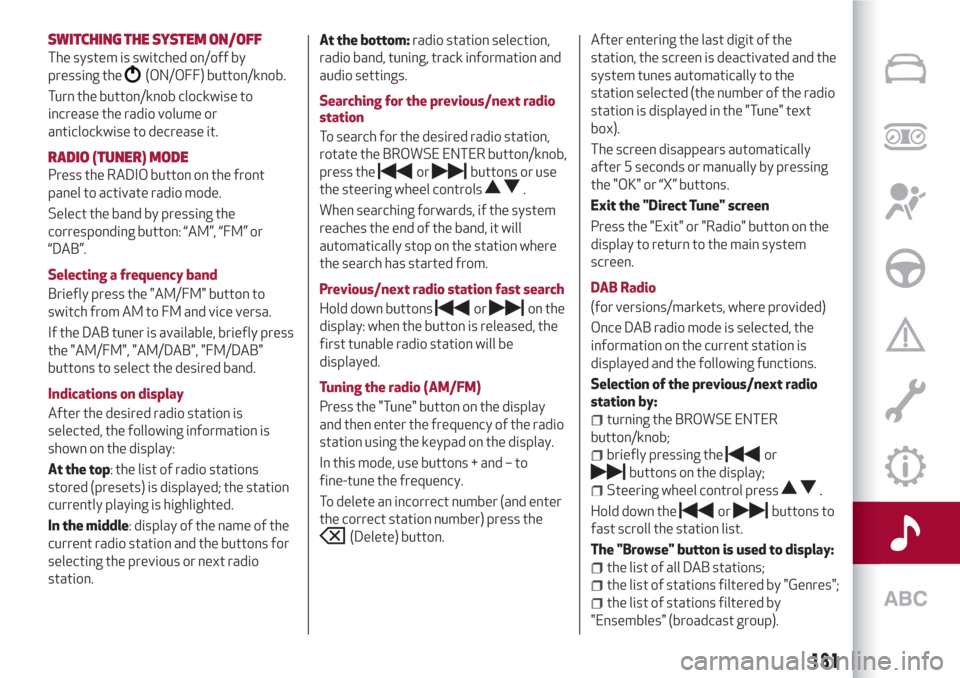
SWITCHING THESYSTEM ON/OFF
The system is switched on/off by
pressing the
(ON/OFF) button/knob.
Turn the button/knob clockwise to
increase the radio volume or
anticlockwise to decrease it.
RADIO (TUNER) MODE
Press the RADIO button on the front
panel to activate radio mode.
Select the band by pressing the
corresponding button: “AM”, “FM” or
“DAB”.
Selecting a frequency band
Briefly press the "AM/FM" button to
switch from AM to FM and vice versa.
If the DAB tuner is available, briefly press
the "AM/FM", "AM/DAB", "FM/DAB"
buttons to select the desired band.
Indications on display
After the desired radio station is
selected, the following information is
shown on the display:
At the top: the list of radio stations
stored (presets) is displayed; the station
currently playing is highlighted.
In the middle: display of the name of the
current radio station and the buttons for
selecting the previous or next radio
station.At the bottom:radio station selection,
radio band, tuning, track information and
audio settings.
Searching for the previous/next radio
station
To search for the desired radio station,
rotate the BROWSE ENTER button/knob,
press theorbuttons or use
the steering wheel controls
.
When searching forwards, if the system
reaches the end of the band, it will
automatically stop on the station where
the search has started from.
Previous/next radio station fast search
Hold down buttons
oron the
display: when the button is released, the
first tunable radio station will be
displayed.
Tuning the radio (AM/FM)
Press the "Tune" button on the display
and then enter the frequency of the radio
station using the keypad on the display.
In this mode, use buttons + and – to
fine-tune the frequency.
To delete an incorrect number (and enter
the correct station number) press the
(Delete) button.After entering the last digit of the
station, the screen is deactivated and the
system tunes automatically to the
station selected (the number of the radio
station is displayed in the "Tune" text
box).
The screen disappears automatically
after 5 seconds or manually by pressing
the "OK" or “X” buttons.
Exit the "Direct Tune" screen
Press the "Exit" or "Radio" button on the
display to return to the main system
screen.
DAB Radio
(for versions/markets, where provided)
Once DAB radio mode is selected, the
information on the current station is
displayed and the following functions.
Selection of the previous/next radio
station by:
turning the BROWSE ENTER
button/knob;
briefly pressing theor
buttons on the display;
Steering wheel control press.
Hold down the
orbuttons to
fast scroll the station list.
The "Browse" button is used to display:
the list of all DAB stations;
the list of stations filtered by "Genres";
the list of stations filtered by
"Ensembles" (broadcast group).
181
Page 184 of 216

Setting the presets
Presets are available in all system modes
and are activated by touching one of the
preset buttons located in the upper area
of the display.
If you are tuned to a radio station that
you wish to store, hold down the button
on the display which corresponds to the
desired preset or until an acoustic
confirmation signal is emitted.
The system can store up to 12 radio
stations in each mode: 3 radio stations
are displayed in the upper area.
Press the "All" button on the display to
show all the radio stations stored in the
frequency band selected.
Audio
To access the "Audio" menu, press the
SETTINGS button on the front panel,
scroll through the menu, then select and
press the "Audio" option on the display.
The following adjustments can be carried
out using the "Audio" menu:
"Equalizer" (for versions/markets,
where provided): to adjust the bass,
medium and treble settings;
"Balance/Fader" (left/right and
front/rear audio balance adjustment);
"Volume/Speed" (excluding versions
with Hi-Fi system) speed-dependent
automatic volume adjustment;
"Loudness" (for versions/markets,
where provided): improves audio quality
at low volumes;
"Auto-On Radio": provides the options
of radio on, radio off or restore status
when the ignition key was last turned to
STOP.
"Radio Off Delay": keeps the radio on
for a preset time after the ignition key is
turned to STOP.
MEDIA MODE
Press the "Source" button to select the
desired audio source among those
available.
Change track (next/previous)
Briefly press the
button or press
on the steering wheel or, alternatively,
turn the BROWSE ENTER button/knob
clockwise to play the next track. Briefly
press the
button or presson the
steering wheel or, alternatively, turn the
BROWSE ENTER button/knob clockwise
to return to the beginning of the track or
return to the beginning of the previous
track of the track has been playing for
less than 8 seconds.Fast forward/rewind through tracks
Press and hold down the
button to
fast forward the selected track or keep
the
button pressed to fast rewind
the track.
Track selection (Browse)
The selection options depend on the
device connected or the CD type
inserted.
NOTE
Bluetooth®devices do not offer
the possibility of scrolling through tracks
using the above categories.
NOTE This button might be disabled for
some
Apple®devices.
Press the "Browse" button to activate
this function on the source being played.
Turn the BROWSE ENTER button/knob
to select the desired category and then
press the button/knob to confirm the
selection.
Press the "X" button to cancel the
function.
Track information display
Press the "Info" button to display the
information on the track being listened to
for devices that support the function.
Press the "X" button to exit the screen.
182
MULTIMEDIA
This chapter describes how to interact
with CD,
Bluetooth®
, AUX (where
provided) and USB operation.
Page 185 of 216
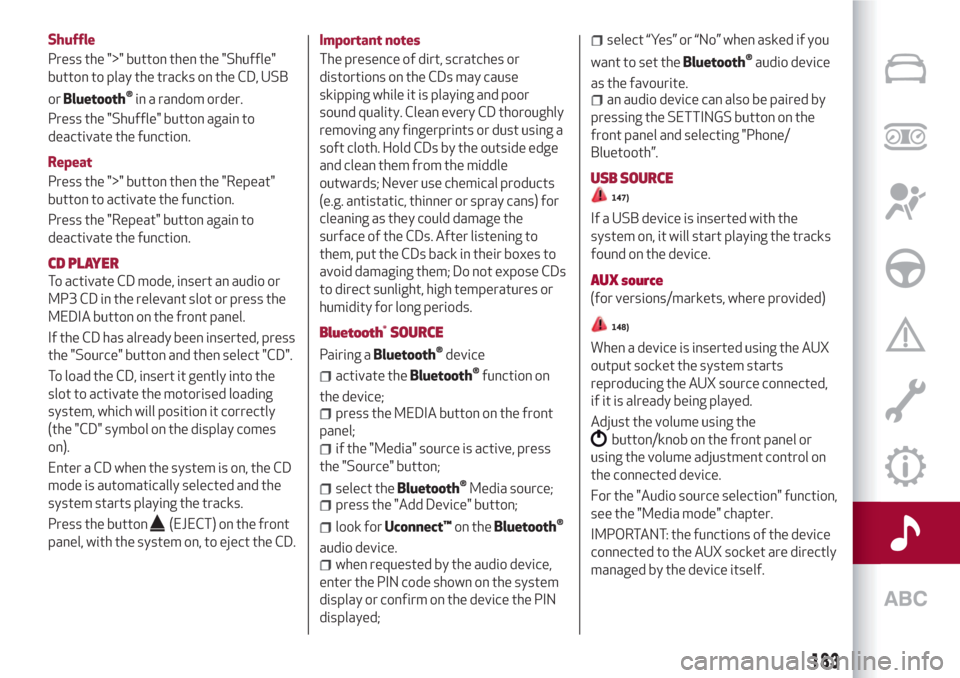
Shuffle
Press the ">" button then the "Shuffle"
button to play the tracks on the CD, USB
or
Bluetooth®in a random order.
Press the "Shuffle" button again to
deactivate the function.
Repeat
Press the ">" button then the "Repeat"
button to activate the function.
Press the "Repeat" button again to
deactivate the function.
CD PLAYER
To activate CD mode, insert an audio or
MP3 CD in the relevant slot or press the
MEDIA button on the front panel.
If the CD has already been inserted, press
the "Source" button and then select "CD".
To load the CD, insert it gently into the
slot to activate the motorised loading
system, which will position it correctly
(the "CD" symbol on the display comes
on).
Enter a CD when the system is on, the CD
mode is automatically selected and the
system starts playing the tracks.
Press the button
(EJECT) on the front
panel, with the system on, to eject the CD.Important notes
The presence of dirt, scratches or
distortions on the CDs may cause
skipping while it is playing and poor
sound quality. Clean every CD thoroughly
removing any fingerprints or dust using a
soft cloth. Hold CDs by the outside edge
and clean them from the middle
outwards; Never use chemical products
(e.g. antistatic, thinner or spray cans) for
cleaning as they could damage the
surface of the CDs. After listening to
them, put the CDs back in their boxes to
avoid damaging them; Do not expose CDs
to direct sunlight, high temperatures or
humidity for long periods.
Bluetooth®SOURCE
Pairing aBluetooth®device
activate theBluetooth®function on
the device;
press the MEDIA button on the front
panel;
if the "Media" source is active, press
the "Source" button;
select theBluetooth®Media source;
press the "Add Device" button;
look forUconnect™on theBluetooth®
audio device.
when requested by the audio device,
enter the PIN code shown on the system
display or confirm on the device the PIN
displayed;
select “Yes” or “No” when asked if you
want to set the
Bluetooth®audio device
as the favourite.
an audio device can also be paired by
pressing the SETTINGS button on the
front panel and selecting "Phone/
Bluetooth”.
USB SOURCE
147)
If a USB device is inserted with the
system on, it will start playing the tracks
found on the device.
148)
When a device is inserted using the AUX
output socket the system starts
reproducing the AUX source connected,
if it is already being played.
Adjust the volume using the
button/knob on the front panel or
using the volume adjustment control on
the connected device.
For the "Audio source selection" function,
see the "Media mode" chapter.
IMPORTANT: the functions of the device
connected to the AUX socket are directly
managed by the device itself.
183
AUX source
(for versions/markets, where provided)